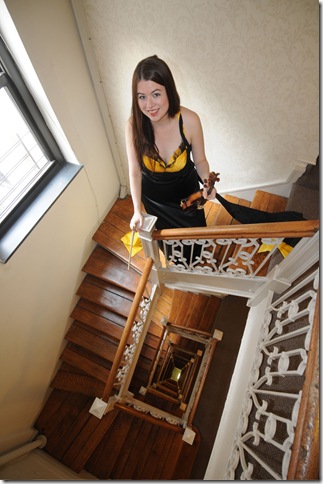It has only become a commonplace of Tchaikovsky criticism in recent years to emphasize his work’s continuity with Russian folk tradition, but as a performance Tuesday night showed, it’s always been right there in plain view.
The Canadian violinist Lara St. John, in an exceptional performance with the South Florida Symphony at the Crest Theatre in Delray Beach, dug deep into the songlines of Mother Russia for her reading of the Tchaikovsky Violin Concerto (in D, Op. 35), particularly in the second movement.
Normally a chance for the soloist for display their expressivity and clarity of tone, St. John’s version of the Canzonetta was played in a halting, sobbing, half-voiced way, with the half-step edges of the melody emphasized to sound like cries. She added ornaments and traded klezmer-style inflections with clarinetist Dave Drosinos, giving the movement a Russo-Jewish folk flavor (or perhaps Roma, in keeping with St. John’s admiration of Gypsy music).
It was most distinctive, and a gutsy artistic move, but it might have seemed like affectation had the rest of the performance not been as impressive as it was. Although there were some less-than-stellar moments of intonation in the first movement, this is a piece St. John clearly knows from the inside out, and she presented it masterfully. Her technique is huge and accurate, and the casual way she holds the violin made the fireworks that often followed even more striking.
It was also entertaining to see her bob along with the beat as the orchestra clicked along in the finale, like a jazzer waiting for the next solo moment, and to hear the click of her heel on the stage as she tapped her right foot along with the rhythm. The orchestra under conductor Sebrina Maria Alfonso was a solid partner, though St. John several times had to turn toward them and urge them on a little faster, particularly in the finale.
The modest house at the Crest Theatre applauded after the first movement, and then again at the end, much more forcefully. St. John deserved a larger crowd, but the audience members on hand were most enthusiastic.
The concert’s second half was devoted to a relative rarity on local concert stages, the Fourth Symphony (in E-flat, Romantic) of Anton Bruckner. It’s one of the Austrian master’s most accessible pieces, and longtime residents familiar with the old WTMI radio station in Miami would recognize the opening bars of the Scherzo as one of its news broadcast “bumps.”
That aside, this is a challenging and long-breathed work that requires canny conducting to bring off; its spaces, so much like the registration changes the veteran organist Bruckner would have played as a matter of daily course, can stop momentum cold if the arc of the music’s narrative isn’t clear.
As a Bruckner conductor, Alfonso prefers faster tempos and shorter pauses, which helped move the music along. She also likes Bruckner’s ländler moments to have some lift, and that gives the music some added shape.
This was a reasonably efficient performance of this symphony; the members of the orchestra, primarily skilled freelancers from the Northeast, were more than capable of handling Bruckner’s vagaries, and it sounded well-practiced. Although the general shape of the symphony was in place, there was some raggedness in spots such as the beginning of the finale, and while the performance had plenty of muscle, it didn’t have the epic quality goes best with Bruckner (the Crest space also doesn’t lend itself well to the composer’s particular kind of sonic structures).
But there was plenty to like about this reading of the Fourth, especially the standout horn playing of Albert Houde, who set the right tone for the work by nailing the first treacherous, exposed opening. The brass section overall was excellent, as that famous Scherzo fanfare showed, and the string ensemble was a good bit better than it was in the Tchaikovsky. If the full measure of Bruckner’s unique style wasn’t available Tuesday night, it was still heartening to see a local organization take on this important music and give a Palm Beach County audience some idea of its communicative power.
The Russian-American pianist Natasha Paremski is the featured soloist on the next series of South Florida Symphony concerts Jan. 11, 12, 14 and 15. She’ll play the Rachmaninov Third Concerto on a program that includes a Debussy rarity, his Scottish March, the Macbeth symphonic poem (Op. 23) of Richard Strauss, and Jean Sibelius’ tone poem Pohjola’s Daughter. Call 954-522-8445 for more information or visit www.southfloridasymphony.org.
